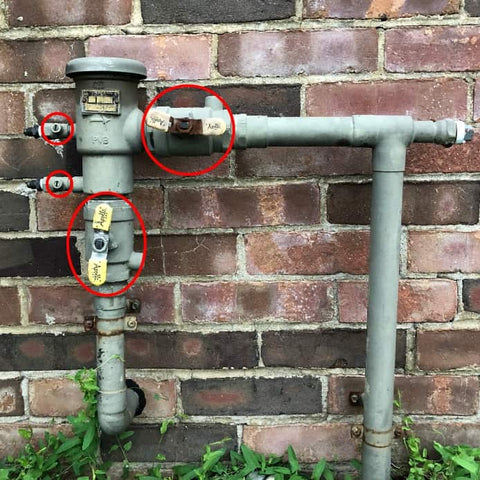Preparing Your Irrigation System for Winter

If you live where the frost line goes below the level of the pipes in the ground in your yard, you need to blow out or drain your irrigation system before the first frost. Some municipalities require mandatory winterization, so check your local rules and regulations.
Most irrigation systems use either PVC pipe or Poly pipe. PVC is generally white and rigid, Poly pipe is generally black and flexible. Both of these kinds of pipe can crack if any amount of moisture is left inside them over winter. In addition to the pipes freezing, other plastic components of the system can crack, including the valves, fittings, and sprinklers. The best way to clear out the system to prevent freezing is to have a “blow-out” done by a qualified landscape or irrigation professional.
Steps To Winterizing an Irrigation System
Here are some important guidelines to follow:
- Always wear proper eye protection. Compressed air can cause serious injury!
- Do not stand over or near any rotor, sprinkler or valve while the system is being blown out.
- Rent an air compressor with Cubic Foot per Minute of 80-100 as anything less than that will not perform the job correctly. Note: It is generally more cost effective to hire a sprinkler company, than it is to rent the equipment yourself.
- Make sure you hook into the line after any backflow device.
- Shut off the water supply and attach the compressor to the main line with a quick coupler or a hose bib.
- Turn on the station farthest from the air compressor, and that is also highest in elevation.
- Close the backflow isolation valves.
- Open the valve on the compressor slowly, which will begin to slowly introduce air into the system.
- Keep the blow out pressure below the maximum operating pressure specifications of the lowest rated part on your line. Example: Is the lowest rated part is a pop-up spray sprinkler and the rated pressure is 45 PSI, than do not exceed 45psi. But is no occasion should you ever exceed more than 80 PSI.
- Now work your way through your zones, ending with the zone closest to the compressor.
- Each station should be blown out until there are no water droplets coming out of the sprinkler head. Usually two minutes per zone is enough - and you can do two short bursts of air instead of one long one.
- Do not continue to blow air through already dry pipes as this can cause damage to the pipes.
- Do NOT run the compressor unless at least one control valve is open.
After all the water has been blown out of the system, disconnect the compressor and then release any air pressure that might remain within the system - manually operate any zone to release pressure in the mainline. If your backflow device or pressure vacuum breaker has any ball valves, open and close those valves a few times to make sure any trapped water has been moved through.
PRO TIP: Leave the ball valves on the backflow preventer open approximately 45 degrees and make sure you open the test cocks.



